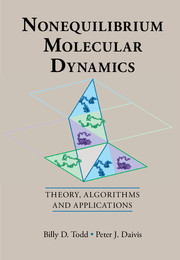Book contents
- Frontmatter
- Contents
- Preface
- 1 Introduction
- 2 Nonequilibrium Thermodynamics and Continuum Mechanics
- 3 Statistical Mechanical Foundations
- 4 Temperature and Thermodynamic Fluxes
- 5 Homogeneous Flows for Atomic Fluids: Theory
- 6 Homogeneous Flows for Atomic Fluids: Applications
- 7 Homogeneous Heat and Mass Transport
- 8 Homogeneous Flows for Molecular Fluids
- 9 Inhomogeneous Flows for Atomic Fluids
- 10 Confined Molecular Fluids
- 11 Generalised Hydrodynamics and Slip
- Bibliography
- Index
1 - Introduction
Published online by Cambridge University Press: 30 March 2017
- Frontmatter
- Contents
- Preface
- 1 Introduction
- 2 Nonequilibrium Thermodynamics and Continuum Mechanics
- 3 Statistical Mechanical Foundations
- 4 Temperature and Thermodynamic Fluxes
- 5 Homogeneous Flows for Atomic Fluids: Theory
- 6 Homogeneous Flows for Atomic Fluids: Applications
- 7 Homogeneous Heat and Mass Transport
- 8 Homogeneous Flows for Molecular Fluids
- 9 Inhomogeneous Flows for Atomic Fluids
- 10 Confined Molecular Fluids
- 11 Generalised Hydrodynamics and Slip
- Bibliography
- Index
Summary
We live in a world out of equilibrium – a nonequilibrium world. We are surrounded by phenomena occurring in nature, in industrial and technological processes and in controlled experiments that we can only understand with the aid of a theoretical framework that encompasses nonequilibrium processes. Our understanding of these phenomena is largely based on a macroscopic theory that starts with the balance equations for the densities of mass, momentum, energy and other macroscopic quantities. To solve these equations, it is necessary to introduce relationships based on experiments that relate the observable properties of materials to the variables that define their macroscopic state. These relationships may describe equilibrium or locally equilibrium states of the material and in this case they are called equations of state. But we also need other relationships that relate the fluxes of properties to the property gradients that drive them. These are called constitutive or transport equations. The main subject of this book is the study of these transport equations and the material properties, such as the transport coefficients that account for the differences in the behaviour of different substances, using molecular dynamics simulation methods.
The molecular dynamics (MD) simulation method was developed soon after the Monte Carlo (MC) method, for the purpose of studying relaxation and transport phenomena [9]. Both MC and MD employed periodic boundary conditions, in which the system of interest is assumed to be replicated periodically in all directions, to limit (but not totally eliminate) the effects of the finite system size. At first, applications of this new technique focused on the structure, dynamics and equations of state of equilibrium systems [10–12]. The development in the 1950s of the Green–Kubo formalism, relating linear transport coefficients to equilibrium fluctuations in the corresponding fluxes [13, 14], made it possible to use equilibrium simulations to study nonequilibrium properties. However these methods, based on the computation of time correlation functions, were difficult to apply to all of the transport properties except self-diffusion due to their large computational requirements in comparison to the computing power available at that time. In addition, they could only address transport processes in the linear regime, i.e. where the flux is directly proportional to the thermodynamic driving force. These factors motivated the development of nonequilibrium molecular dynamics (NEMD) methods.
- Type
- Chapter
- Information
- Nonequilibrium Molecular DynamicsTheory, Algorithms and Applications, pp. 1 - 4Publisher: Cambridge University PressPrint publication year: 2017



